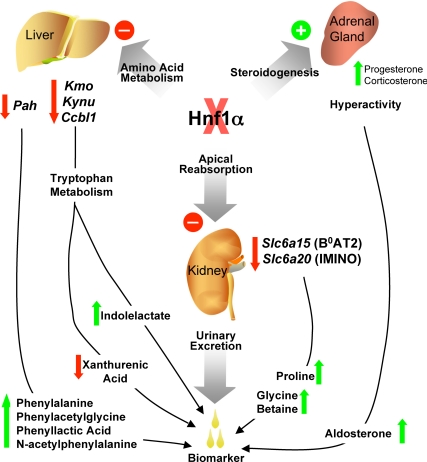Figure 8.
Summary of metabolomic findings in Hnf1a-null mice. Identification of biomarkers in the urine of Hnf1a-null mice enabled discovery of several altered biochemical and physiological pathways. Hyperactive adrenal glands produce excess progesterone leading to increase in aldosterone. Several amino acid pathways are altered in Hnf1a-null mice, principally those of phenylalanine and tryptophan. Reduced phenylalanine hydroxylase (Pah) enzyme inhibits conversion of phenylalanine to tyrosine, thereby causing a build-up of phenylalanine and its bacterial metabolites. Reduction in mRNA transcripts of enzymes key in the kynurenine pathway of tryptophan metabolism may lead to the observed decrease in urinary xanthurenic acid. Additionally, this blockage in the kynurenine pathway may result in increased clearance of tryptophan through the secondary indole pathway. The renal apical transporters B0AT2 (Slc6a15) and IMINO (Slc6a20) are decreased in Hnf1a-null mice, thereby contributing to urinary loss of proline and glycine betaine. All of these markers are excreted in the urine, an easily obtainable biofluid in which to find clinically useful biomarkers for diagnosis of disease.

